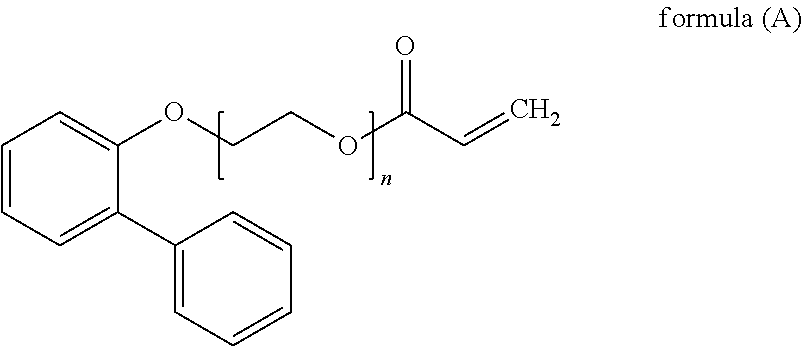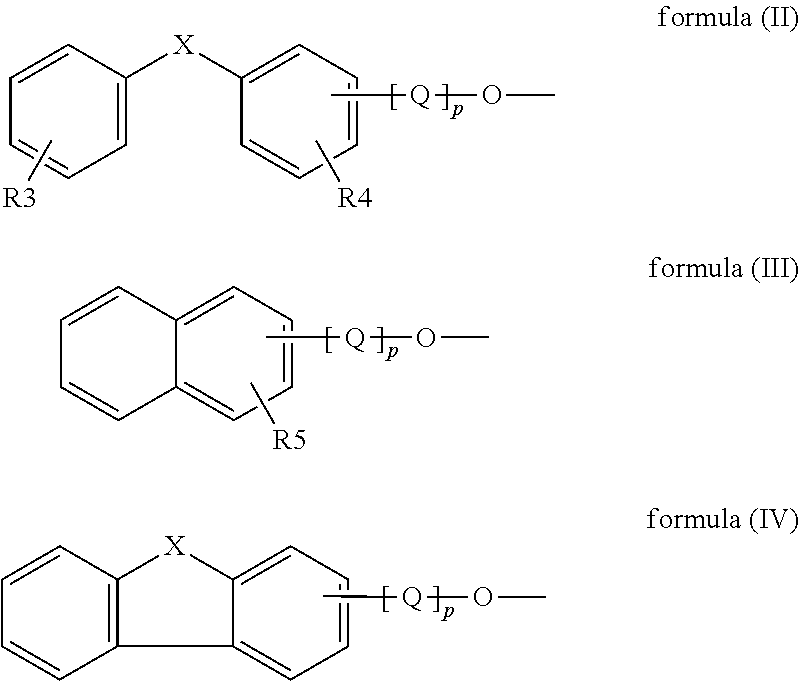Digital printing inks
a technology of digital printing and inks, applied in the field of printing ink compositions, can solve the problems of poor adhesion to plastics, low flexibility, deformation of substrates,
- Summary
- Abstract
- Description
- Claims
- Application Information
AI Technical Summary
Problems solved by technology
Method used
Image
Examples
example 1
Synthesis of 2-(4-phenylphenoxyl)ethan-1-ol
[0078]
[0079]20.0 g 4-hydroxy biphenyl (0.11765 moles), 9.412 g sodium hydroxide (0.2353 moles) and 150 ml of water were mixed in a two necked round bottomed flask fitted with a condenser and magnetic stirrer and heated to 100° C. until all of the solids had dissolved. The mixture was then cooled to 60° C. and 18.94 g of 2-chloroethanol (0.2353 moles) were added and the mixture heated at 50-60° C. with stirring for 3½ hours. The mixture was then cooled to room temperature and 200 ml of dichloromethane was added. The mixture was added to a separating flask and the mixture was allowed to separate. The organic phase was collected and dried with anhydrous magnesium sulphate. The solvent was then removed using a rotary evaporator to yield the product. The yield was 18.53 g (73.6%) of a white solid. The product was analyzed by NMR and FT-IR.
example 2
Synthesis of 2-(4-phenylphenoxyl)ethyl prop-2-enoate
[0080]
[0081]8.0 g of the product from Example 1 (0.03738 moles), 2.96 g of acrylic acid (0.04112 moles), 20 ml of toluene, 0.04 g of p-toluene sulphonic acid and 0.04 g of p-methoxy phenol were mixed in a flask with a Dean and Stark apparatus attached. The mixture was heated to reflux for a total of 20 hours. Air was blown through the reaction mixture throughout the reaction. The mixture was then cooled to room temperature and 50 ml of toluene was added. The mixture was then extracted with 100 ml of 10% aqueous potassium carbonate and then 2×100 ml of water. The organic phase was then dried with anhydrous magnesium sulphate and the solvent removed using a rotary evaporator to yield the product. The yield was 10.0 g (99.8%) of a light grey solid. The product was analysed by NMR and FT-IR.
example 3
Synthesis of 2-(naphthalen-1-yloxy)ethan-1-ol
[0082]
[0083]20.0 g 1-naphthol (0.1387 moles), 11.1 g sodium hydroxide (0.2775 moles) and 150 ml of water were mixed in a two necked round bottomed flask fitted with a condenser and magnetic stirrer and heated to 100° C. until all of the solids had dissolved. The mixture was then cooled to 60° C. and 22.335 g of 2-chloroethanol (0.2775 moles) were added and the mixture heated at 50-60° C. with stirring for 3½ hours. The mixture was then cooled to room temperature and 200 ml of dichloromethane was added. The mixture was added to a separating flask and the mixture was allowed to separate. The organic phase was collected and dried with anhydrous magnesium sulphate. The solvent was then removed using a rotary evaporator to yield the product. The yield was 24.0 g (91.9%) of a brown liquid. The product was analysed by NMR and FT-IR.
PUM
| Property | Measurement | Unit |
|---|---|---|
| particle size distribution | aaaaa | aaaaa |
| particle size distribution | aaaaa | aaaaa |
| particle size distribution | aaaaa | aaaaa |
Abstract
Description
Claims
Application Information
 Login to View More
Login to View More - R&D
- Intellectual Property
- Life Sciences
- Materials
- Tech Scout
- Unparalleled Data Quality
- Higher Quality Content
- 60% Fewer Hallucinations
Browse by: Latest US Patents, China's latest patents, Technical Efficacy Thesaurus, Application Domain, Technology Topic, Popular Technical Reports.
© 2025 PatSnap. All rights reserved.Legal|Privacy policy|Modern Slavery Act Transparency Statement|Sitemap|About US| Contact US: help@patsnap.com



